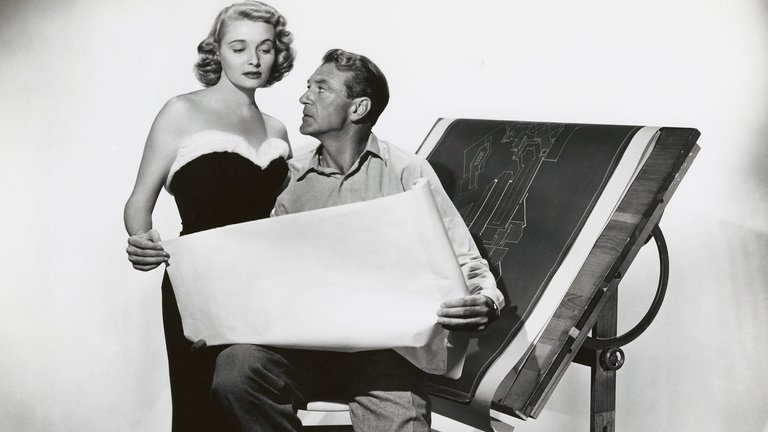Film Review: The Fountainhead (1949)

Those who like their history simplified tend to reduce the 20th Century to one giant struggle between the forces of individualist freedom, embodied in capitalism, on one hand, and the forces of collectivist conformity, embodied in socialism, on the other. One of the most passionate and radical proponents of the former was American writer Ayn Rand, whose works, later developed into a philosophical concept known as Objectivism, had a large influence on American conservatives and libertarians. One of her most successful works was the 1943 novel The Fountainhead, which six years later became the basis for the eponymous film directed by King Vidor.
The protagonist of the film is Howard Roark (played by Gary Cooper), an architect who has developed his very personal views on how buildings should look, without any adherence to tradition or popular tastes. Roark’s inability to compromise seriously hampered his career and forced him to make ends meet as a physical labourer in a quarry owned by the family of Dominique Francon (played by Patricia Neal), a woman who used to be an architectural critic for the New York Banner, a newspaper owned by Gail Wynand (played by Raymond Massey), an influential self-made media mogul. Dominique, despite previously criticising Roark’s work, notices him and, not knowing who he really is, feels attracted to him, which leads to a brief and passionate sexual encounter. Roark gradually begins winning clients, leading to the design of the prestigious Enright Building, and would eventually design a home for Wynand, who in the meantime married Dominique. Wynand, who doesn’t know of his wife’s past liaison with the architect, becomes Roark’s friend. Their friendship is tested when Roark agrees to help his old but incompetent acquaintance Peter Keating (played by Kent Smith) design a major housing project, but only on the condition that his ideas are followed to the letter. When this doesn’t happen, Roark decides to blow up the building and is brought to trial. Wynand initially decides to defend his actions in his newspaper, but when his staff, board members, and the public turn against him, he reluctantly abandons his friend, who is left to try to sway the jury by himself.
Rand wrote her novel at a time when socialism, thanks to the experiences of the Great Depression and the Second World War, enjoyed enormous popularity and was widely believed to represent the only solution to all social, economic, and political problems. The heroic figure of Howard Roark, believed to be modelled on the real-life figure of the famous architect Frank Lloyd Wright, one of the iconic names of modernist architecture, was created to counter such views, both in his actions—his uncompromising and stubborn rejection of societal pressure—and, finally, in his courtroom speech near the end of the novel and film. When the film was made, the emerging Cold War and the deep association of socialism with the dangers of Soviet Communism made Rand’s novel appear as a healthy counterbalance to the trends of previous years. As such, it was very appealing to Warner Bros., whose boss Jack Warner cleverly started the purge of leftists in Hollywood to rid himself of increasingly troublesome actors, screenwriters, and directors, many of whom held views 180 degrees away from Rand. The right-wing views of Rand, who also wrote the screenplay, corresponded to those of director King Vidor, who was considered one of the most talented filmmakers of mid-20th Century Hollywood. It is through his stylish direction, clever production design by Edward Carrere based on modernist architecture, and a strong musical score by veteran Max Steiner that these ideas became distilled into a melodrama that an average viewer, unburdened by ideology and politics, could easily comprehend. Vidor made the film not only visually appealing but also added a strong dose of implied eroticism, with many shots that give Freudian suggestions, such as phallic-shaped buildings or the use of a power-driller as a metaphor for penetration.
These images are often associated with Patricia Neal, a young actress who easily plays both an object of desire and a woman torn between following her heart and doing the “proper” thing. Neal did a good job, and the same can be said for veteran character actor Raymond Massey, who is quite convincing in the role of the self-made tycoon who, when confronted with the embodiment of pure individualist ideals in Roark, fails the test. Gary Cooper, on the other hand, isn’t as convincing in the role of the protagonist and, despite having a torrid and widely publicised real-life affair with Neal (which nearly cost him his marriage), lacks chemistry with his partner. The flowery dialogue by Rand doesn’t help either, although other experienced actors don’t fare any better. The Fountainhead was, after its premiere, rejected by critics, although it had solid results at the box office. Rand later expressed her dissatisfaction with the film, considering it not fully faithful to her novel, and that was the reason why she would reject any suggestions to have Atlas Shrugged, her other famous novel, filmed. However, at the end of the day, The Fountainhead is a well-made and enjoyable film that could be appreciated even by those viewers who reject the ideology behind it.
RATING: 7/10 (+++)
Blog in Croatian https://draxblog.com
Blog in English https://draxreview.wordpress.com/
InLeo blog https://inleo.io/@drax.leo
InLeo: https://inleo.io/signup?referral=drax.leo
Unstoppable Domains: https://unstoppabledomains.com/?ref=3fc23fc42c1b417
Hiveonboard: https://hiveonboard.com?ref=drax y
Bitcoin Lightning HIVE donations: https://v4v.app/v1/lnurlp/qrcode/drax
Rising Star game: https://www.risingstargame.com?referrer=drax
1Inch: https://1inch.exchange/#/r/0x83823d8CCB74F828148258BB4457642124b1328e
BTC donations: 1EWxiMiP6iiG9rger3NuUSd6HByaxQWafG
ETH donations: 0xB305F144323b99e6f8b1d66f5D7DE78B498C32A7
Posted using CineTV